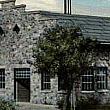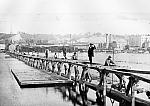
Grand Rapids Water Story, 19th Century, Part III
Grand Rapids Hydraulic Company
Older than the incorporated city, taking an active part in the community’s every day life, an important figure in some of the gravest problems faced by the municipality, yet almost a total stranger to thousands of citizens—this is the Grand Rapids Hydraulic Company.
Although it has been intimately connected with the history of Grand Rapids since 1848, it is to the general public today a creature of mystery, surrounded by a haze of rumors and hearsay tales. The real Hydraulic Company, its aims, workings, place in the community, and present status are little known.
Events arising from the financial difficulties of the company promise to bring it again prominently before the people within the near future. The interests of the public demand that all haziness hanging over the situation be dispelled. The Evening Press has sought, through a special investigation, to ascertain the facts in connection with the company, divested of their load of vague rumors and uncertainties. Its finding, the result of impartial inquiry, will be given in detail.
Company in a Receiver’s Hands
The Grand Rapids Hydraulic Company is at present a bankrupt concern in charge of a receiver. It has been in the hands of a receiver since April 1893. During that time it has barely paid running expenses. The receiver, Mr. T. J. O’Brien, was appointed for the benefit of the bondholders. Now a deal is on among these bondholders to make some arrangement whereby they will realize something on their investment.
The officers of the company are: President and treasurer, D. A. Crow; vice president, John E. More; secretary, C. Marsman; directors, Willard Kingsley, J. E. More, A. C. Sekell, C. Marsman, and D. A. Crow. The company is daily supplying water to between 1,000 and 1,500 customers. It has about sixteen or seventeen miles of mains, a pumping station on Canal Street gravel road, and a standpipe on the hill. It has not gone forward since the receiver was appointed eleven years ago. In some respects it has gone backward.
Gave City Its First Water Supply
The Hydraulic Company came into existence in the fall of 1848, before the city was incorporated. It gave Grand Rapids its first public water supply, and held the field alone for twenty-six years.
The company was originally organized to furnish the thickly settled districts of the village of Grand Rapids with spring water for domestic purposes. The gravity system was adopted, wooden pipes being laid from springs on the hillsides to carry water to the houses in the valley. Until the reorganization of the company in 1886, the gravity system was used alone. In 1886 the pump system was adopted.
As the beginning of the gravity system, wooden “pump-log” pipes were laid from a large spring near the present Central High School site to carry water to the houses along Monroe Street. This pipeline extended down Fountain Street to Ionia, thence to Monroe, and down to the foot of the hill. The National Hotel, located on the present site of the Morton House, was one of the big customers of the company.
What the Charter Provides
On April 2, 1848, the company was duly incorporated, receiving its charter from the legislature. It took the name of the Grand Rapids Hydraulic Company. Its declared purpose in the charter was to furnish a supply of pure and wholesome water for domestic purposes and for fire protection. The charter was broad, giving the company the right to enter upon and use streets, lands and springs in and about the village as might be requisite for its legitimate work. The franchise given was without limit, although the legislature reserved the right to repeal it.
The charter specified that the supply of the company was “to be obtained from the springs of water in and about said village, from Coldbrook, from the lake or lakes from which it has it source, or either of them, and from no other source.” This charter is still in effect and the company is still operating under its provisions.
Expansion was speedy with the original company. In 1849, the company took possession of springs south of Wealthy Avenue and east of Jefferson Avenue. Pipes were run from this source to Fulton Street and thence to the river. Later on the Kuster and Mangold spring east of Ottawa Street, between Bridge and Hastings Streets, was connected with the system.
How the Gravity System Grew
Greater demand for water following the rapid growth of the town, an effort was made in 1872 to increase the service by constructing a reservoir on the Penny Eighty, south of Wealthy Avenue, in the vicinity of Terrace (now Prospect) and Madison Avenues. Until 1886 the several springs mentioned furnished the old Hydraulic Company’s entire source of supply.
The gravity system answered the needs of the village as far as supplying water for domestic purposes was concerned. It failed, however, to meet all demands for fire protection. The force of the streams was barely sufficient to take water up to the second stories of houses in the valley.
In 1874 the city, feeling the need of better fire protection, established a water works system of its own. The new and superior service had a harmful effect upon the Hydraulic Company.
In 1886, when the old gravity system had been outdistanced by the city’s pump system, the Hydraulic Company was reorganized and revolutionized by Moses R. Crow and others. The gravity system was abandoned. Land was purchased on the Canal Street gravel road and a pump house was erected. Iron mains were laid in various parts of the city, and the Hydraulic Company began to gain back some of its lost prestige. Its strong claim for patronage was based on it source of supply—spring water—as compared with the river water furnished by the city.
The revolutionizing of the system was made largely with borrowed money. Affairs went wrong with the company. It could not pay interest, and in 1893 went into the hands of a receiver, appointed at the request of the bondholders. Before it lost its hold the company made several attempts to buy out the city plant. Later negotiations were carried on looking to the sale of the Hydraulic plant to the city. All deals fell through.
Grand Rapids Evening Press, October 12, 1904.
Transcribed by Rebecca Smith-Hoffman

 facebook
facebook











